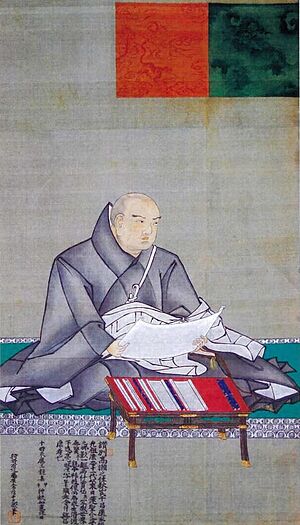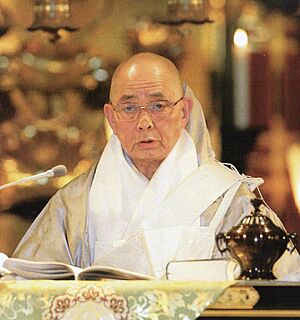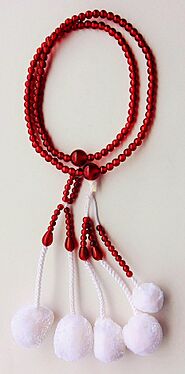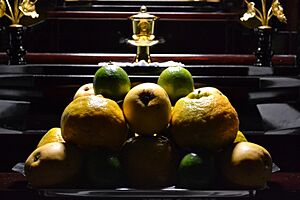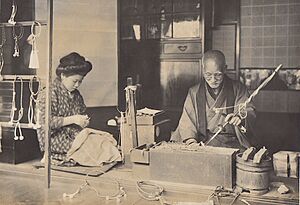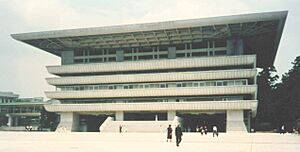Nichiren Shōshū facts for kids
Quick facts for kids  Nichiren Shōshū |
|
|---|---|
| 日 蓮 正 宗 | |

Taiseki-ji Head Temple, Fujinomiya, Shizuoka, Japan
|
|
| Abbreviation | NST |
| Classification | Nichiren Buddhism |
| Scripture | Lotus Sutra Gosho writings of Nichiren |
| Theology | Honmonji Buddhism |
| High Priest | Nichinyo Shonin |
| Liturgy | “The Liturgy of Nichiren Shoshu” |
| Headquarters | Taiseki-ji Sohonzan |
| Founder | Nichiren Daishonin |
| Origin | 4 May 1253 Minobu, Yamanashi (June 2), later transferred to Taiseki-ji (1290) |
| Members | Over 800,000 (as of January 2021) |
| Logo | Rounded crane |
Nichiren Shōshū (pronounced Nee-chee-ren Sho-shoo) is a type of Nichiren Buddhism. It follows the teachings of a Japanese Buddhist priest named Nichiren (1222–1282). This group believes Nichiren was its founder through his main student, Nikko Shonin (1246–1333). Nikko Shonin founded the main temple, Taiseki-ji, which is near Mount Fuji in Japan. People who follow this religion are called Hokkeko members. In the United States, their main temple is Enichizan Myohoji Temple in Los Angeles, California.
Nichiren Shōshū teaches that other forms of Buddhism, like those taught by Shakyamuni Buddha, are not complete or right for today's world. Instead, they focus only on Nichiren's teachings. A key practice is chanting "Nam-Myoho-Renge-Kyo" and reading parts of the Lotus Sutra.
Followers of Nichiren Shōshū worship an object called the Dai Gohonzon. Their religious symbol is a round crane bird. Leaders and members believe their way is "The True Buddhism." They call Nichiren the "Sacred Original 'True' Buddha" and "Great Holy Teacher." They also believe Nikko Shonin and the high priests who followed him are the only true successors to Nichiren. The current leader is the 68th High Priest, Hayase Myo-e Ajari Nichinyo Shonin, who became leader in 2005.
Contents
Understanding Nichiren Shoshu's History
After Nichiren passed away, his followers had different ideas about his teachings. This led to many different groups. During a time in Japan called the Meiji Restoration, the government brought many of these groups together.
In 1900, the Taiseki-ji temple separated from one of these larger groups. It changed its name to Nichirenshu Fuji-ha. This name showed it was the "Nichiren School of the Fuji area." In 1913, the group changed its name again to “Nichiren Shoshu.” This new name means "The Orthodox School of Nichiren." It was supposedly given by Emperor Taisho, suggesting the group's claim to be the true path. Sometimes, people in the Shizuoka area of Japan call it Nichiren Masamune.
Exploring Nichiren Shoshu Practices
The main temple, Taiseki-ji, is at the bottom of Mount Fuji in Japan. Many Nichiren Shōshū followers from all over the world visit Taiseki-ji. They go there to chant to the Dai Gohonzon. They believe this object physically holds Nichiren's spirit.
Unlike some other Buddhist practices, Nichiren Shōshū believes the Lotus Sutra is the only true Buddhist teaching. They also believe chanting Nam-Myoho-Renge-Kyo is the only way to reach Buddhahood. This means anyone can become a Buddha, no matter their life situation, gender, or job. They also believe you don't have to wait to be reborn in a future life to achieve this.
Nichiren Shōshū says it has over 700 temples and centers in Japan. It also has 24 temples outside Japan. More than 800,000 people around the world are members.
Nichiren Shōshū believes its High Priests have a direct line of succession from Nikko Shonin. They say Nichiren chose Nikko Shonin to continue spreading his Buddhist practice. Other Nichiren Buddhist groups also claim this, but some do not. Nichiren Shōshū says this line is proven by certain old documents. The current leader is the 68th High Priest, Nichinyo Shōnin (born 1935).
Nichiren Shōshū priests wear white and grey robes with a white surplice. They believe Nichiren wore these colors. Since 1872, Japanese Buddhist priests, including those in Nichiren Shōshū, have been allowed to marry.
The group does not have strict rules about marriage, money, or personal habits. This includes things like divorce, what clothes to wear, or what to eat or drink.
The group also does not accept money or gifts from people who are not members. They believe this is because non-believers might bring "bad karma." Nichiren and Nikko Shonin taught this idea. Because of this, a new member's joining fee is usually not paid by another member. This is only allowed in very rare cases, like if someone is very poor.
The group says there are three ways for members to make donations:
- Sharing their religious practice with others by chanting Nam Myoho Renge Kyo and doing Shakubuku.
- Giving food and money to support their local temple and its priests.
- Doing free work, like cleaning, for the temple. This is an old Asian practice to gain Buddhist merit.
The main group for lay members, "Hokkeko–Rengo–Kai," is in Toshima, Tokyo.
Important Buddhist Writings
The following writings are very important in Nichiren Shōshū:
- The Threefold Lotus Sutra (all three parts).
- Letters from important past leaders like Nikko Shonin (2nd), Nichiu Shonin (9th), and Nichikan Shonin (26th).
- Letters from Nichiren Daishonin called "Gosho." Some famous ones include:
- Securing the Peace of this Land by Propagating True Buddhism (1258)
- Opening Your Eyes from Blindness (1272)
- The True Object of Worship (1273)
- Selecting the Right Time (1275)
- Paying Back Your Debts of Gratitude (1276)
Some other writings are also respected, but less important. These include:
- The ten volumes of Mohe Zhiguan ("Great Concentration and Mind Contemplation").
- The Hokke Gengi ("Essentials of the Lotus Sutra").
About Hokkeko Members

Regular members belong to groups called Hokkekō. These groups help members feel connected. They also study Nichiren Shoshu teachings and plan trips to the main temple in Japan. Most members go to services at a local temple or in private homes if there isn't a temple nearby. A priest usually leads services, but sometimes lay leaders do if a priest isn't there. When they meet, members often study Nichiren Shōshū teachings, especially Nichiren's writings called Gosho.
The official symbol of Nichiren Shōshū is a round crane bird (Tsuru-no-Maru). Another symbol is the eight-spoked wheel of the Noble Eightfold Path, called Rimbo. There is also a tortoise symbol for Nikko Shonin, who is seen as Nichiren's true successor. The "Three Friends of Winter" symbol is also found on temple altars, representing Nichimoku Shonin.
Core Religious Beliefs
Nichiren Shōshū beliefs include:
- The idea of "Five periods of time + eight categories" for Buddhist writings.
- The idea that 3,000 different worlds exist within one moment of life.
- Their view of the "Three Truths."
The Idea of "Buddhist Slander"
The group believes that other religions and different forms of Buddhism are wrong. They call mixing religions "Slander" against the teachings of Nichiren. They also believe that supporting other religions can bring bad karma, punishment, and suffering.
Karma and Rebirth Teachings
The group teaches that children choose their parents based on the parents' past and present good or bad actions (karma). They also believe that all living things create their own karma. This karma affects how they are reborn. All beings, including humans and animals, choose to be reborn in ways that help spread the Buddhist enlightenment of Nam-Myoho-Renge-Kyo.
Shakyamuni Buddha's Teachings Today
Nichiren Shōshū believes that the many forms of Buddhism taught by Shakyamuni Buddha no longer help people achieve Buddhahood in the modern age. They say this "Third Age of Buddhism" began in the year 1052. They also believe Nichiren was fulfilling a prophecy from Chapter 21 of the Lotus Sutra. This prophecy talks about someone who will help many people find enlightenment in this age.
"…Like the rays of the sun and the moon that dispel the darkness of phenomena, this person will practice in the world, dispel the darkness of all humanity and lead immeasurable numbers of bodhisattvas to finally attain the One Vehicle" – Chapter 21: The Mystical Powers of Tathagata Buddha.
The "Three Great Secret Laws"
Nichiren Shoshu teaches that Nichiren revealed three main spiritual practices:
- Precepts: Following Buddhist promises in daily life.
- Meditation: Clearing the mind by chanting "Nam-Myoho-Renge-Kyo".
- Wisdom: Following the religion's teachings through the Head Temple.
These three practices are linked to the "Three Great Secret Laws":
- The Dai-Gohonzon is the main object of worship. It represents the precepts.
- The Daimoku (chanting Nam Myoho Renge Kyo) is the main prayer. It represents meditation.
- The Dai-Sekiji no Honmon Kaidan (Taiseki-ji) is the main place of worship. It represents wisdom.
About the Lotus Sutra
The Lotus Sutra is central to the group's teachings. They divide it into two parts:
- "Theoretical Teachings" (Chapters 1–14): These are taught by Shakyamuni Buddha, who became a Buddha in Bodhgaya, India.
- "Essential Teachings" (Chapters 15–28): In these chapters, Shakyamuni says his enlightenment in India was only temporary. He actually became a Buddha at a mysterious, timeless point in the Universe.
Because of this, all other Buddhas, like Amida Nyorai and Dainichi Nyorai, are seen as part of one original Buddha.
Another teaching is that Chapter 2 of the Lotus Sutra does not fully explain how Shakyamuni Buddha became enlightened. They believe this secret was revealed in Chapter 16 by Ākāśagarbha Bodhisattva to Nichiren. This led Nichiren to teach the public chanting of Nam-Myoho-Renge-Kyo.
The group also teaches that:
- Chanting Chapter 2 means rejecting other religions and forms of Buddhism.
- Chanting Chapter 16 helps a person achieve Buddhahood. This "hidden secret" is called "Jigyo–Keta." It means widely spreading the practice to non-believers.
What Nam-Myoho-Renge-Kyo Means
The group teaches that Nam-myoho-renge-kyo is the most important part of Nichiren's teachings. It is explained in the Ongi Kuden as follows:
| Word | Meaning | What Nichiren Shoshu Believes It Means |
|---|---|---|
| Nam | Devotion | Giving your life to spreading Myoho-renge-kyo and to Nichiren Daishonin. He is seen as the Buddha who holds the truth, the Dai Gohonzon. |
| Myoho | The "Mysterious Law" | Ignorance and enlightenment are connected. Hell and heaven are also connected. |
| Renge | The Nelumbo nucifera (lotus flower) | Cause and effect are one. This is like the lotus flower, which shows how karma works. |
| Kyo | Buddhist Sutra or teachings | All things that happen in the past, present, and future. This is shown by the Buddha of Compassion, Nichiren Daishonin. |
Ceremonies and Rituals
Nichiren Shoshu holds many ceremonies. Some remember important people or events. Others are for life events like becoming a Buddhist, marriages, and funerals. Visitors can become members by taking the Gojukai ceremony. In this ceremony, they promise to follow Nichiren Shōshū's teachings and respect the Dai-Gohonzon.
Former members who have not been active can take the Kankai ceremony to renew their vows.
- Gojukai ceremony for new members.
- Kaigen-shu for blessing Gohonzons, prayer beads, and gravestones.
- Kankai-kishi ceremony for former members.
- Kantoku ceremony for passing down a family Gohonzon.
- Toba (Stupa) memorials for family and friends who have passed away.
- Adding names to the Kakocho memorial book for home altars.
- Gokaihi ceremony at the Hoando for prayers and care of the Dai-Gohonzon.
Donations to a Nichiren Shōshū temple are private. They are put in small white envelopes labeled Gokuyo. These envelopes have a checklist for the donation's purpose. Money from non-members is not allowed.
Nichiren Shōshū gives different types of Gohonzons to members. These are the only ones approved by the group.
- Joju type: A large carved wooden or paper scroll. It is for big temples or families who protected the Dai Gohonzon.
- Regular sized katagi: A common woodblock Gohonzon for members.
- Large size katagi Tokubetsu: A larger woodblock Gohonzon given by the Chief Priest for special reasons.
- Mamori: A pocket-sized Gohonzon for members who travel.
All Gohonzons given by Nichiren Shōshū are blessed by a High Priest. This ceremony happens at the Hoando building in Taiseki-ji temple. They believe this blessing gives the Gohonzon the same power as the Dai-Gohonzon. When a member passes away, their Gohonzon must be returned to a Nichiren Shōshū temple. Members are not allowed to copy or photograph the Gohonzon without permission.
The Main Object of Worship
The Dai Gohonzon is a special scroll with Sanskrit and Chinese characters. It is written on a plank of Japanese camphorwood. It is the only object of worship for followers. The group says Nichiren wrote it on October 12, 1279.
The group believes the Dai Gohonzon is like Nichiren himself. Every Nichiren Shōshū temple and home has a gohonzon. These are copies of the Dai Gohonzon made by the High Priests.
The Dai Gohonzon is kept in the Hoando worship hall at the Taiseki-ji temple. The priests will only show it to the public all the time when the Emperor of Japan converts to Nichiren Shōshū. They also believe this will happen when Kosen-rufu is achieved, meaning Nichiren Shōshū becomes the main religion in the world by Japanese imperial law. Unlike other Gohonzons at the temple, it does not have shikimi branches or Taiko drums.
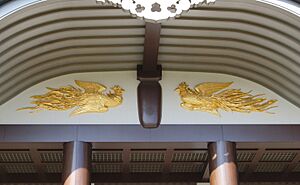
Copies of the Dai Gohonzon made by the High Priests are called gohonzon. Most temple gohonzons are carved wood tablets. They are black with gold writing. Gohonzons in temples are personally copied by a High Priest.
Hokkeko members can ask their local priest for a personal gohonzon. These are printed on paper as small scrolls. The local priest sends all requests to the Head Temple. Once approved, the gohonzons are sent to the local priest, who gives them to the members. In this ceremony, the member promises to believe in Nichiren's teachings and practice the religion faithfully.
Leaders of Nichiren Shoshu
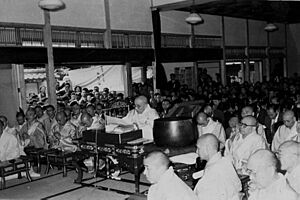
The leaders of Nichiren Shoshu are called High Priests. Here is a list of some of them:
| Rank | High Priest | Date of Birth | Date of Death |
|---|---|---|---|
| 1 | Nichiren Daishonin | 16 February 1222 | 13 October 1282 |
| 2 | Nikko Shonin | 8 March 1246 | 7 February 1333 |
| 3 | Nichimoku Shonin | 28 April 1260 | 15 November 1333 |
| 9 | Nichiu Shonin | 16 April 1402 | 29 September 1482 |
| 26 | Nichikan Shonin | 7 August 1665 | 19 August 1726 |
| 65 | Nichijun Shonin | 10 October 1898 | 17 November 1959 |
| 66 | Nittatsu Shonin | 15 April 1902 | 22 July 1979 |
| 67 | Nikken Shonin | 19 December 1922 | (resigned on 16 December 2005) 20 September 2019 |
| 68 | Nichinyo Shonin (Nichinyo Hayase) |
25 February 1935 | Current High Priest (Incumbent) since 16 December 2005 |
- The dates listed are when each High Priest passed away.
Groups No Longer Part of Nichiren Shoshu
Over time, some groups that were once connected to Nichiren Shoshu separated or were asked to leave.
Kenshokai (Clear and Orthodox Group), 1974
In 1974, a group called Myōshinkō was asked to leave Nichiren Shōshū. This happened after they protested against another group, Soka Gakkai. Myōshinkō believed that the Shohondo building was the true and permanent national sanctuary for the Dai Gohonzon, even without the Japanese Emperor converting. The group later changed its name to Fuji Taisekiji Kenshōkai. This group is known for growing quickly in Japan.
Shōshinkai (Orthodox Faith Group), 1980
In 1980, some Nichiren Shōshū priests and their supporters formed a group called Shōshinkai. They were asked to leave the Head Temple by the 67th High Priest, Nikken Shonin. They questioned if Nikken was the rightful new leader and criticized Soka Gakkai's influence. At that time, Soka Gakkai supported Nikken. Shōshinkai still calls itself the true Nichiren Shōshū. Many of these older priests have passed away, and their temples have returned to Nichiren Shoshu.
Soka Gakkai (Value Creation Society), 1991
Nichiren Shōshū formally separated from the Soka Gakkai and the Soka Gakkai International (SGI) on November 28, 1991.
Soka Gakkai started as a lay group connected to a temple in the Taiseki-ji area. It was founded by Tsunesaburo Makiguchi in 1928. The group grew under its second president, Jōsei Toda. It followed Nichiren Shōshū's teachings until disagreements arose with the third Soka Gakkai President, Daisaku Ikeda.
Problems began as early as 1956. The second president of Soka Gakkai, Josei Toda, reportedly told the 65th High Priest Nichijun Shonin that their group no longer fully followed Nichiren Shoshu teachings.
In 1974, a Soka Gakkai leader suggested a split from Nichiren Shōshū. High Priest Nittatsu Hosoi refused to create a committee to oversee temple matters. He also warned that the Dai-Gohonzon might be put back into a special treasury building. This would mean only a few trusted followers could see it.
These disagreements led to a full separation in 1991. Nichiren Shōshū removed Soka Gakkai's status as a lay organization. This also meant Soka Gakkai lost its tax-exempt status in Japan. Daisaku Ikeda was also removed from his leadership role by High Priest Nikken.
Another reason for conflict was that Soka Gakkai started building "Community Centers" instead of funding new Nichiren Shōshū temples. On September 30, 1997, Nichiren Shōshū also separated from all Soka Gakkai International members.
See also
- Nichiren Shū



